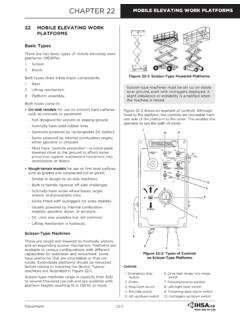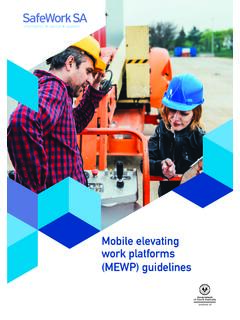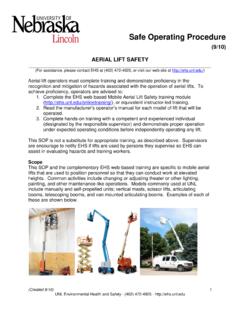Transcription of Safe Use of Lifting Equipment and Lifting Accessories
1 safe Use of Lifting Equipment and Lifting Accessories STFC Safety Code No 26 Rev. , Issued May 2022 Note - This docment may have been superseded by a more recent version. Please check on the SHE website for the most up-to-date version of this document. Issue Number: Issue Date: 24/05/2022 Author: SHE Group Page 2 of 31 Version History 1 Initial launch March 2010 Update training frequency to 3 years October 2011 Minor change to para November 2011 Minor change to section January 2012 Amendments to audit checklist and definitions May 2013 Slight change to definitions ,8 & 9 June 2013 Document Retention Policy Added August 2014 Update due to new HSE ACoP being issued and include climbing harnesses.
2 September 2015 Added table of acronyms Changes to ; ; and January 2016 Change to para and added PTW Appendix October 2016 Minor update to reflect the launch of SHE Assure October 2018 Minor update to May 2022 Note - This docment may have been superseded by a more recent version. Please check on the SHE website for the most up-to-date version of this document. Issue Number: Issue Date: 24/05/2022 Author: SHE Group Page 3 of 31 Contents 1. 2. SCOPE ..5 3. DEFINITIONS ..6 ACRONYMS USED IN THIS DOCUMENT: ..6 Lifting Equipment AND Lifting Accessories .
3 6 mobile CRANE ..6 CRANE ..7 LOAD ..7 EXAMINATION SCHEME ..7 THOROUGH EXAMINATION ..7 BASIC LIFT ..7 STANDARD LIFT ..7 COMPLEX LIFT ..7 safe WORKING LOAD ..7 CRANE LOLER MANAGER ..7 Lifting LIAISON OFFICER ..8 LELA USER ..8 4. RESPONSIBILITIES ..9 DIRECTORS ..9 LOLER MANAGERS ..9 MANAGERS ..9 LELA USERS ..10 Lifting LIAISON OFFICERS ..11 SHE 5. REFERENCES ..13 APPENDIX 1. DECISION TREE - IS MY Equipment SUBJECT TO LOLER? ..14 APPENDIX 2. PROCESS FLOW CHARTS FOR DESIGN, USE AND INSPECTION..15 APPENDIX 3. TRAINING ..18 APPENDIX 4.
4 CENTRAL REGISTER PREFIXES FOR Lifting Equipment AND Accessories ..20 APPENDIX 5. Lifting PLANS FOR COMPLEX LIFTS AND mobile CRANES ..21 APPENDIX 6. AUDIT CHECKLIST ..26 APPENDIX 7. DOCUMENT RETENTION POLICY ..27 APPENDIX 8. EXAMPLE PERMIT TO work ON OR IN THE VICINITY OF OVERHEAD CRANES..28 Note - This docment may have been superseded by a more recent version. Please check on the SHE website for the most up-to-date version of this - This docment may have been superseded by a more recent version. Please check on the SHE website for the most up-to-date version of this document.
5 Issue Number: Issue Date: 24/05/2022 Author: SHE Group Page 5 of 31 safe Use of Lifting Equipment and Lifting Accessories 1. Purpose The failure and/or misuse of Lifting Equipment has the potential to cause serious personal injury, significant damage to property and loss of time and money. Failure of any load-bearing part of any Lifting Equipment is reportable to the Health and Safety Executive as a Dangerous Occurrence under the Reporting of Injuries, Diseases and Dangerous Occurrences Regulations (1995) (RIDDOR). The STFC has over 5000 registered items of Lifting Equipment .
6 The failure and/or misuse of Lifting Equipment is to a large extent preventable, and STFC aims to proactively manage the risks associated with the purchase, storage and use of Lifting Equipment and Lifting Accessories . With regard to Lifting Equipment and Lifting Accessories , the Lifting Operations and Lifting Equipment Regulations (1998) (LOLER) require the STFC to: Ensure that Lifting operations are planned, supervised and carried out in a safe manner by people who are competent; Provide Lifting Equipment and Accessories that are suitable, stable and have sufficient strength; Mark safe Working Loads [SWL] on Lifting Equipment and Accessories .
7 And Thoroughly examine and inspect Lifting Equipment and Accessories and keep reports of these examinations and any defects that are found. These principal legal duties regarding Lifting Equipment and Lifting Accessories are contained in LOLER 1998, but duties are also imposed by the Health and Safety at work etc. Act 1974; Management of Health and Safety at work Regulations 1999; Workplace (Health, Safety & Welfare) Regulations 1992; and Provision and use of work Equipment Regulations 1998. BS 7121-1:2006 Code of Practice for safe Use of Cranes has been used in the preparation of this code.
8 This code seeks to establish consistent standards across all STFC sites and provides guidelines on the responsibilities of relevant STFC personnel involved. A LOLER Decision Tree has been issued by HSE and is presented in Appendix 1. Summary process flowcharts are presented in Appendix 2. 2. Scope This code applies to all staff, contractors, visitors, users and tenants using Lifting Equipment and Accessories on STFC sites. This code applies to the design, purchase, registration, user inspection, thorough examination, use and maintenance of all Lifting Equipment and Accessories at STFC sites, including in-house designed and constructed Lifting Equipment and Accessories .
9 Lifting Equipment and Lifting Accessories introduced by visitors, facility users, tenants and contractors to STFC sites are also within the scope of this code. Note - This docment may have been superseded by a more recent version. Please check on the SHE website for the most up-to-date version of this document. Issue Number: Issue Date: 24/05/2022 Author: SHE Group Page 6 of 31 This code also addresses the registration, inspection and testing of mobile elevating work Platforms (MEWPs), lifts and Fork Lift Trucks, however their safe use is addressed by other specific codes.
10 For the purposes of this SHE Code fall arrest, fall restrai nt and climbing harnesses should be considered Lifting Equipment and subject to the statutory inspection programme established for Lifting Equipment and Lifting Accessories . 3. Definitions Acronyms used in this document: LELA Lifting Equipment and Lifting Accessories LE Lifting Equipment LA Lifting Accessories HSE Health and Safety Executive ACoP Approved Code of Practice LOLER Lifting operations and Lifting Equipment Regulations RIDDOR Reporting of injuries, diseases and dangerous occurrences Regulations PUWER Provision and use of work Equipment Regulations SWL safe working load WLL Working load limit MEWP mobile elevating working platform FLT Fork lift truck CoC Certificate of conformity LLO Lifting liaison officer For the purposes of this code the following definitions apply.






